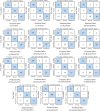Identification of COVID-19 samples from chest X-Ray images using deep learning: A comparison of transfer learning approaches
- PMID: 32773400
- PMCID: PMC7592691
- DOI: 10.3233/XST-200715
Identification of COVID-19 samples from chest X-Ray images using deep learning: A comparison of transfer learning approaches
Abstract
Background: The novel coronavirus disease 2019 (COVID-19) constitutes a public health emergency globally. The number of infected people and deaths are proliferating every day, which is putting tremendous pressure on our social and healthcare system. Rapid detection of COVID-19 cases is a significant step to fight against this virus as well as release pressure off the healthcare system.
Objective: One of the critical factors behind the rapid spread of COVID-19 pandemic is a lengthy clinical testing time. The imaging tool, such as Chest X-ray (CXR), can speed up the identification process. Therefore, our objective is to develop an automated CAD system for the detection of COVID-19 samples from healthy and pneumonia cases using CXR images.
Methods: Due to the scarcity of the COVID-19 benchmark dataset, we have employed deep transfer learning techniques, where we examined 15 different pre-trained CNN models to find the most suitable one for this task.
Results: A total of 860 images (260 COVID-19 cases, 300 healthy and 300 pneumonia cases) have been employed to investigate the performance of the proposed algorithm, where 70% images of each class are accepted for training, 15% is used for validation, and rest is for testing. It is observed that the VGG19 obtains the highest classification accuracy of 89.3% with an average precision, recall, and F1 score of 0.90, 0.89, 0.90, respectively.
Conclusion: This study demonstrates the effectiveness of deep transfer learning techniques for the identification of COVID-19 cases using CXR images.
Keywords: COVID-19; Chest X-Ray Image; image identification; transfer learning.
Figures





References
-
- Novel Coronavirus – China, World Health Organization, (2020). https://www.who.int/csr/don/12-january-2020-novel-coronavirus-china/en/.
-
- Statement on the second meeting of the International Health Regulations Emergency Committee regarding the out of novel coronavirus -nCoV), World Health Organization, (2019). https://www.who.int/news-room/detail/30-01-2020-statement-on-the-second-....
-
- WHO Director-General’s opening remarks at the media briefing on COVID-19 - 11 March World Health Organization, (2020). https://www.who.int/dg/speeches/detail/who-director-general-s-opening-re....
-
- JHU, COVID-19 Dashboard by the Center for Systems Science and Engineering (CSSE) at Johns Hopkins University (JHU), (2020). https://coronavirus.jhu.edu/map.html.
-
- Zhao S., Lin Q., Ran J., Musa S.S., Yang G., Wang W., Lou Y., Gao D., Yang L., He D., et al., Preliminary estimation of the basic reproduction number of novel coronavirus -nCoV) in China, from to: A data-driven analysis in the early phase of the out, International Journal of Infectious Diseases 92 (2020), 214–217. - PMC - PubMed
Publication types
MeSH terms
LinkOut - more resources
Full Text Sources
Medical
Miscellaneous

